Post-Activation Potentiation’s Impact on Specialized Strike Strength in Elite Male Boxers: An Acute Study
Abstract
1. Introduction
2. Materials and Methods
2.1. Experimental Approach to the Problem
2.2. Participant
2.3. Experimental Design
2.4. Outcome Measures
2.4.1. Back Squat 1 RM Test
2.4.2. Speed Strike Strength and Maximum Strike Strength Test
2.5. Statistical Analysis
3. Results
3.1. Jab
3.2. Cross
3.3. Speed Strike Strength
3.3.1. Jab
3.3.2. Cross
4. Discussion
4.1. Maximum Strike Strength
4.2. Speed Strike Strength
4.3. Limitations
5. Conclusions
Author Contributions
Funding
Institutional Review Board Statement
Informed Consent Statement
Data Availability Statement
Conflicts of Interest
References
- Chaabène, H.; Tabben, M.; Mkaouer, B.; Franchini, E.; Negra, Y.; Hammami, M.; Amara, S.; Chaabène, R.B.; Hachana, Y. Amateur Boxing: Physical and Physiological Attributes. Sports Med. 2015, 45, 337–352. [Google Scholar] [CrossRef]
- Dunn, E.C.; Humberstone, C.E.; Iredale, K.F.; Blazevich, A.J. A Damaging Punch: Assessment and Application of a Method to Quantify Punch Performance. Transl. Sports Med. 2019, 2, 146–152. [Google Scholar] [CrossRef]
- Smith, M.S.; Dyson, R.J.; Hale, T.; Janaway, L. Development of a Boxing Dynamometer and Its Punch Force Discrimination Efficacy. J. Sports Sci. 2000, 18, 445–450. [Google Scholar] [CrossRef]
- Lenetsky, S.; Brughelli, M.; Nates, R.J.; Neville, J.G.; Cross, M.R.; Lormier, A.V. Defining the Phases of Boxing Punches: A Mixed-Method Approach. J. Strength Cond. Res. 2020, 34, 1040–1051. [Google Scholar] [CrossRef]
- Wu, G.; Guo, Y.; Zhang, L.; Chen, C. A Physical Fitness–Evaluation System for Outstanding Chinese Male Boxers. PeerJ 2024, 12, e17271. [Google Scholar] [CrossRef]
- Blazevich, A.J.; Babault, N. Post-Activation Potentiation Versus Post-Activation Performance Enhancement in Humans: Historical Perspective, Underlying Mechanisms, and Current Issues. Front. Physiol. 2019, 10, 1359. [Google Scholar] [CrossRef]
- Maloney, S.J.; Turner, A.N.; Fletcher, I.M. Ballistic Exercise as a Pre-Activation Stimulus: A Review of the Literature and Practical Applications. Sports Med. 2014, 44, 1347–1359. [Google Scholar] [CrossRef]
- Krzysztofik, M.; Wilk, M.; Stastny, P.; Golas, A. Post-Activation Performance Enhancement in the Bench Press Throw: A Systematic Review and Meta-Analysis. Front. Physiol. 2021, 11, 598628. [Google Scholar] [CrossRef]
- Miarka, B.; Del Vecchio, F.B.; Franchini, E. Acute Effects and Postactivation Potentiation in the Special Judo Fitness Test. J. Strength Cond. Res. 2011, 25, 427–431. [Google Scholar] [CrossRef]
- Aandahl, H.S.; Von Heimburg, E.; Van den Tillaar, R. Effect of Postactivation Potentiation Induced by Elastic Resistance on Kinematics and Performance in a Roundhouse Kick of Trained Martial Arts Practitioners. J. Strength Cond. Res. 2018, 32, 990–996. [Google Scholar] [CrossRef]
- Suchomel, T.J.; Nimphius, S.; Stone, M.H. The Importance of Muscular Strength in Athletic Performance. Sports Med. 2016, 46, 1419–1449. [Google Scholar] [CrossRef]
- Seitz, L.B.; Haff, G.G. Factors Modulating Post-Activation Potentiation of Jump, Sprint, Throw, and Upper-Body Ballistic Performances: A Systematic Review with Meta-Analysis. Sports Med. 2016, 46, 231–240. [Google Scholar] [CrossRef]
- Wilson, J.M.; Duncan, N.M.; Marin, P.J.; Brown, L.E.; Loenneke, J.P.; Wilson, S.M.C.; Jo, E.; Lowery, R.P.; Ugrinowitsch, C. Meta-Analysis of Postactivation Potentiation and Power: Effects of Conditioning Activity, Volume, Gender, Rest Periods, and Training Status. J. Strength Cond. Res. 2013, 27, 854–859. [Google Scholar] [CrossRef]
- Aagaard, P.; Simonsen, E.B.; Andersen, J.L.; Magnusson, P.; Dyhre-Poulsen, P. Increased Rate of Force Development and Neural Drive of Human Skeletal Muscle Following Resistance Training. J. Appl. Physiol. 2002, 93, 1318–1326. [Google Scholar] [CrossRef]
- Maffiuletti, N.A.; Aagaard, P.; Blazevich, A.J.; Folland, J.; Tillin, N.; Duchateau, J. Rate of Force Development: Physiological and Methodological Considerations. Eur. J. Appl. Physiol. 2016, 116, 1091–1116. [Google Scholar] [CrossRef]
- Pierce, J.D.; Reinbold, K.A.; Lyngard, B.C.; Goldman, R.J.; Pastore, C.M. Direct Measurement of Punch Force during Six Professional Boxing Matches. J. Quant. Anal. Sports 2006, 2. [Google Scholar] [CrossRef]
- Smith, M.S. Physiological Profile of Senior and Junior England International Amateur Boxers. J. Sports Sci. Med. 2006, 5, 74–89. [Google Scholar]
- Peng, F.; Zhang, L.; Zhou, C. How to determine an appropriate sample size in sports science experimental research. J. Shanghai Univ. Sport 2023, 47, 26–36. [Google Scholar]
- Miller, T.A. NSCA’s Guide to Tests and Assessments; Human Kinetics: Champaign, IL, USA, 2012. [Google Scholar]
- Kilduff, L.P.; Bevan, H.R.; Kingsley, M.I.C.; Owen, N.J.; Bennett, M.A.; Bunce, P.J.; Hore, A.M.; Maw, J.R.; Cunningham, D.J. Postactivation Potentiation in Professional Rugby Players: Optimal Recovery. J. Strength Cond. Res. 2007, 21, 1134–1138. [Google Scholar] [CrossRef]
- Mcbride, J.M.; Nimphius, S.; Erickson, T.M. The Acute Effects of Heavy-Load Squats and Loaded Countermovement Jumps on Sprint Performance. J. Strength Cond. Res. 2005, 19, 893–897. [Google Scholar]
- Turner, A.; Baker, E.; Miller, S. Increasing the Impact Force of the Rear Hand Punch. Strength Cond. J. 2011, 33, 2–9. [Google Scholar] [CrossRef]
- Liu, Y.; Zhu, Z.; Chen, X.; Deng, C.; Ma, X.; Zhao, B. Biomechanics of the Lead Straight Punch of Different Level Boxers. Front. Physiol. 2022, 13, 1015154. [Google Scholar] [CrossRef]
- D’Addio, G.; Cesarelli, M.; Romano, M.; Faiella, G.; Lullo, F.; Pappone, N. Kinematic and EMG Patterns Evaluation of Upper Arm Reaching Movements. In Proceedings of the 2012 4th IEEE RAS & EMBS International Conference on Biomedical Robotics and Biomechatronics (BioRob), Rome, Italy, 24–27 June 2012; IEEE: New York, NY, USA, 2012; pp. 1383–1387. [Google Scholar]
- Filimonov, V.I.; Koptsev, K.N.; Husyanov, Z.M.; Nazarov, S.S. Boxing: Means of Increasing Strength of the Punch. Strength Cond. J. 1985, 7, 65–66. [Google Scholar] [CrossRef]
- Loturco, I.; Nakamura, F.Y.; Artioli, G.G.; Kobal, R.; Kitamura, K.; Cal Abad, C.C.; Cruz, I.F.; Romano, F.; Pereira, L.A.; Franchini, E. Strength and Power Qualities Are Highly Associated with Punching Impact in Elite Amateur Boxers. J. Strength Cond. Res. 2016, 30, 109–116. [Google Scholar] [CrossRef]
- Hukkanen, E.; Häkkinen, K. Effects of Sparring Load on Reaction Speed and Punch Force during the Precompetition and Competition Periods in Boxing. J. Strength Cond. Res. 2017, 31, 1563–1568. [Google Scholar] [CrossRef]
- Mack, J.; Stojsih, S.; Sherman, D.; Dau, N.; Bir, C. Amateur Boxer Biomechanics and Punch Force. In Proceedings of the Isbs-Conference Proceedings Archive, Marquette, MI, USA, 19–23 July 2010. [Google Scholar]
- Giovani, D.; Nikolaidis, P.T. Differences in Force-Velocity Characteristics of Upper and Lower Limbs of Non-Competitive Male Boxers. Int. J. Exerc. Sci. 2012, 5, 106–113. [Google Scholar] [CrossRef]
- Lenetsky, S.; Harris, N.; Brughelli, M. Assessment and Contributors of Punching Forces in Combat Sports Athletes: Implications for Strength and Conditioning. Strength Cond. J. 2013, 35, 1–7. [Google Scholar] [CrossRef]
- Loturco, I.; Pereira, L.A.; Kobal, R.; Fernandes, V.; Reis, V.P.; Romano, F.; Alves, M.; Freitas, T.T.; McGuigan, M. Transference Effect of Short-Term Optimum Power Load Training on the Punching Impact of Elite Boxers. J. Strength Cond. Res. 2021, 35, 2373–2378. [Google Scholar] [CrossRef]
- Masakado, Y.; Akaboshi, K.; Nagata, M.; Kimura, A.; Chino, N. Motor Unit Firing Behavior in Slow and Fast Contractions of the First Dorsal Interosseous Muscle of Healthy Men. Electroencephalogr. Clin. Neurophysiol. Electromyogr. Mot. Control 1995, 97, 290–295. [Google Scholar] [CrossRef]
- Garbisu-Hualde, A.; Santos-Concejero, J. Post-Activation Potentiation in Strength Training: A Systematic Review of the Scientific Literature. J. Hum. Kinet. 2021, 78, 141–150. [Google Scholar] [CrossRef]
- Gouvêa, A.L.; Fernandes, I.A.; César, E.P.; Silva, W.A.B.; Gomes, P.S.C. The Effects of Rest Intervals on Jumping Performance: A Meta-Analysis on Post-Activation Potentiation Studies. J. Sports Sci. 2013, 31, 459–467. [Google Scholar] [CrossRef]
- Kilduff, L.P.; Owen, N.; Bevan, H.; Bennett, M.; Kingsley, M.I.C.; Cunningham, D. Influence of Recovery Time on Post-Activation Potentiation in Professional Rugby Players. J. Sports Sci. 2008, 26, 795–802. [Google Scholar] [CrossRef]
- Sweeney, H.L.; Stull, J.T. Alteration of Cross-Bridge Kinetics by Myosin Light Chain Phosphorylation in Rabbit Skeletal Muscle: Implications for Regulation of Actin-Myosin Interaction. Proc. Natl. Acad. Sci. USA 1990, 87, 414–418. [Google Scholar] [CrossRef]
- Cabrera, C.A.; Morales, J.; Greer, F.; Pettitt, R.W. Exercise Bouts at Three Different Intensities Fail to Potentiate Concentric Power. Int. J. Exerc. Sci. 2009, 2, 38. [Google Scholar] [CrossRef]
- Ruddock, A.D.; Wilson, D.C.; Thompson, S.W.; Hembrough, D.; Winter, E.M. Strength and Conditioning for Professional Boxing: Recommendations for Physical Preparation. Strength Cond. J. 2016, 38, 81–90. [Google Scholar] [CrossRef]
- Chen, C.; Ali, Z.; Rehman Rashid, M.A.; Samethanovna, M.U.; Wu, G.; Mukhametkali, S.; Dilnur, T. Relationship between Isokinetic Strength of the Knee Joint and Countermovement Jump Performance in Elite Boxers. PeerJ 2023, 11, e16521. [Google Scholar] [CrossRef]
- Moritani, T.; DeVries, H.A. Neural Factors versus Hypertrophy in the Time Course of Muscle Strength Gain. Am. J. Phys. Med. Rehabil. 1979, 58, 115–130. [Google Scholar]
- Kraemer, W.J.; Newton, R.U. Training for Muscular Power. Phys. Med. Rehabil. Clin. N. Am. 2000, 11, 341–368. [Google Scholar] [CrossRef]
- Moore, R.L.; Stull, J.T. Myosin Light Chain Phosphorylation in Fast and Slow Skeletal Muscles in Situ. Am. J. Physiol.-Cell Physiol. 1984, 247, C462–C471. [Google Scholar] [CrossRef]
- Vandervoort, A.A.; McComas, A.J. A Comparison of the Contractile Properties of the Human Gastrocnemius and Soleus Muscles. Eur. J. Appl. Physiol. 1983, 51, 435–440. [Google Scholar] [CrossRef]
- Cleary, C.J.; Cook, S.B. Postactivation Potentiation in Blood Flow–Restricted Complex Training. J. Strength Cond. Res. 2020, 34, 905–910. [Google Scholar] [CrossRef]
- Hamada, T.; Sale, D.G.; MacDougall, J.D.; Tarnopolsky, M.A. Interaction of Fibre Type, Potentiation and Fatigue in Human Knee Extensor Muscles. Acta Physiol. Scand. 2003, 178, 165–173. [Google Scholar] [CrossRef]
- Desmedt, J.E.; Godaux, E. Ballistic Contractions in Man: Characteristic Recruitment Pattern of Single Motor Units of the Tibialis Anterior Muscle. J. Physiol. 1977, 264, 673–693. [Google Scholar] [CrossRef]
- Newton, R.U.; Kraemer, W.J.; Häkkinen, K.; Humphries, B.J.; Murphy, A.J. Kinematics, Kinetics, and Muscle Activation during Explosive Upper Body Movements. J. Appl. Biomech. 1996, 12, 31–43. [Google Scholar] [CrossRef]
- West, D.J.; Cunningham, D.J.; Crewther, B.T.; Cook, C.J.; Kilduff, L.P. Influence of Ballistic Bench Press on Upper Body Power Output in Professional Rugby Players. J. Strength Cond. Res. 2013, 27, 2282–2287. [Google Scholar] [CrossRef]
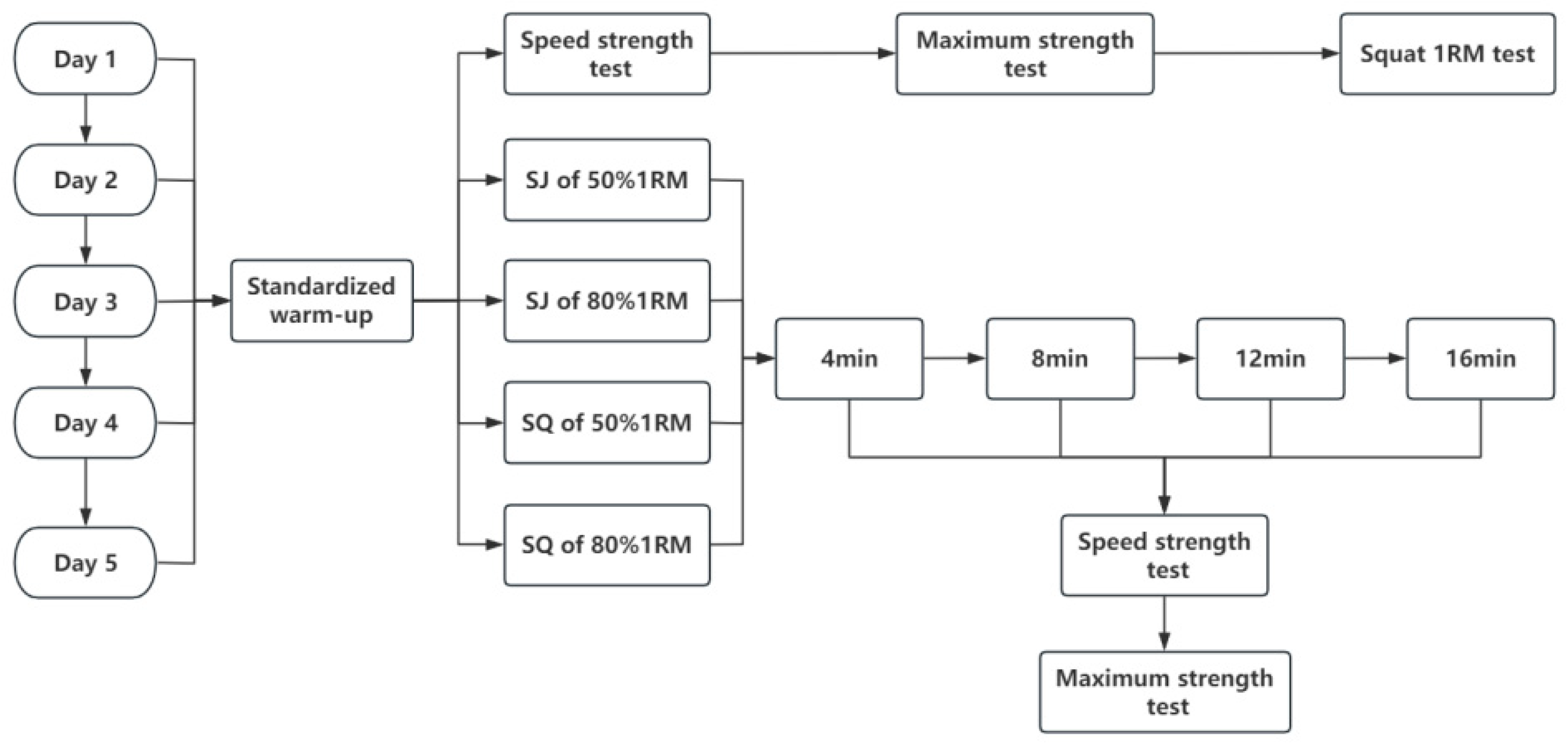
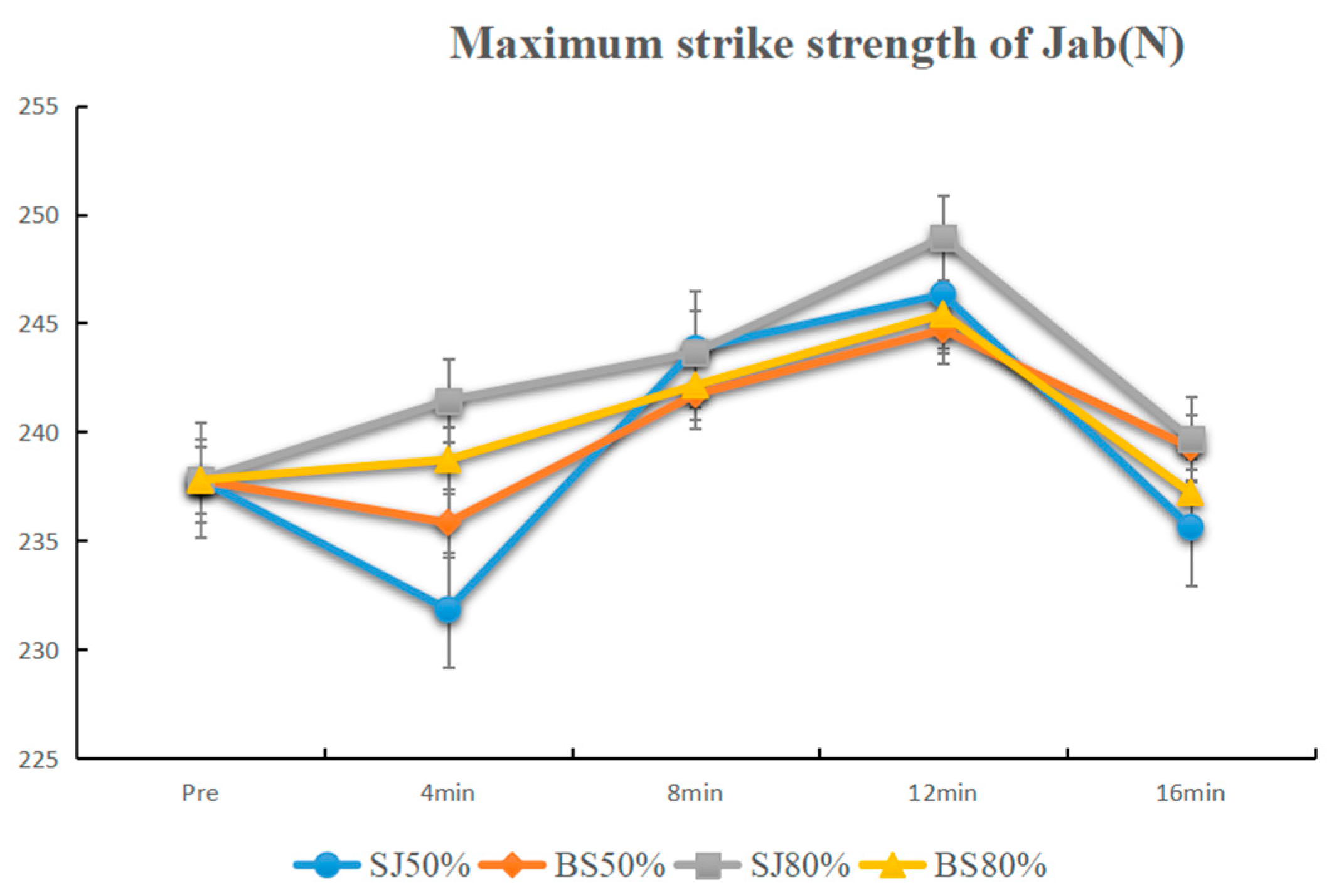
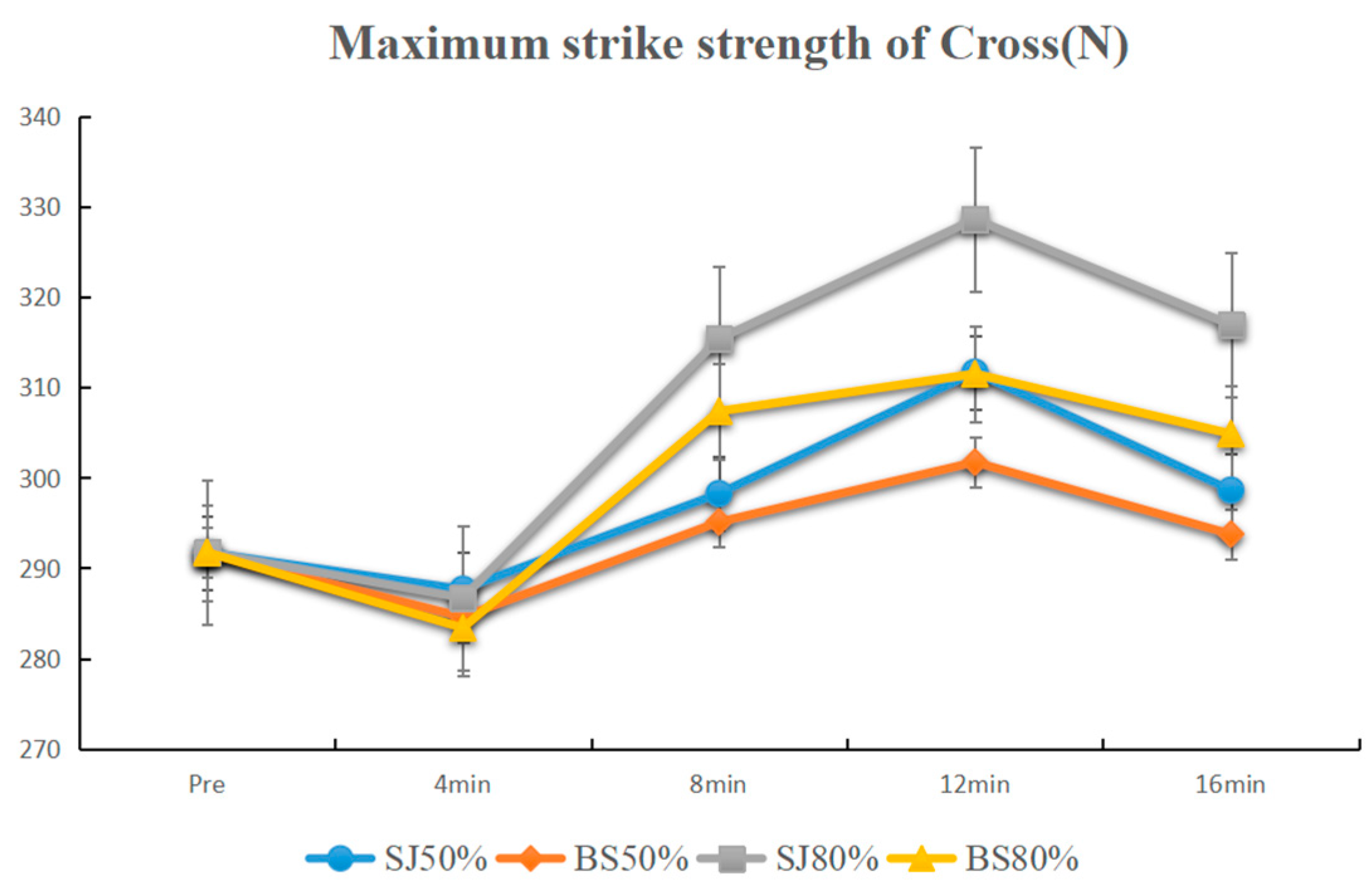
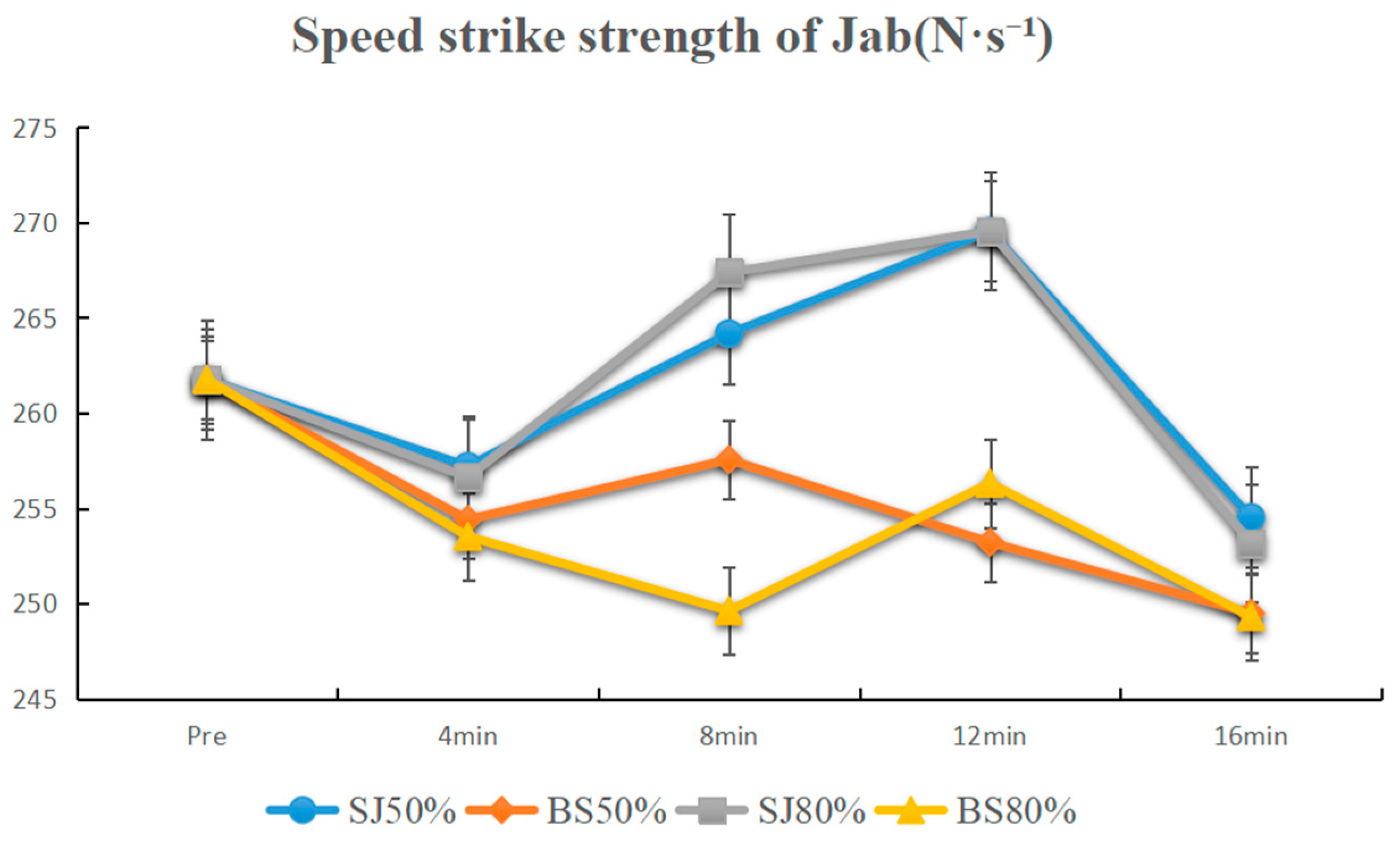
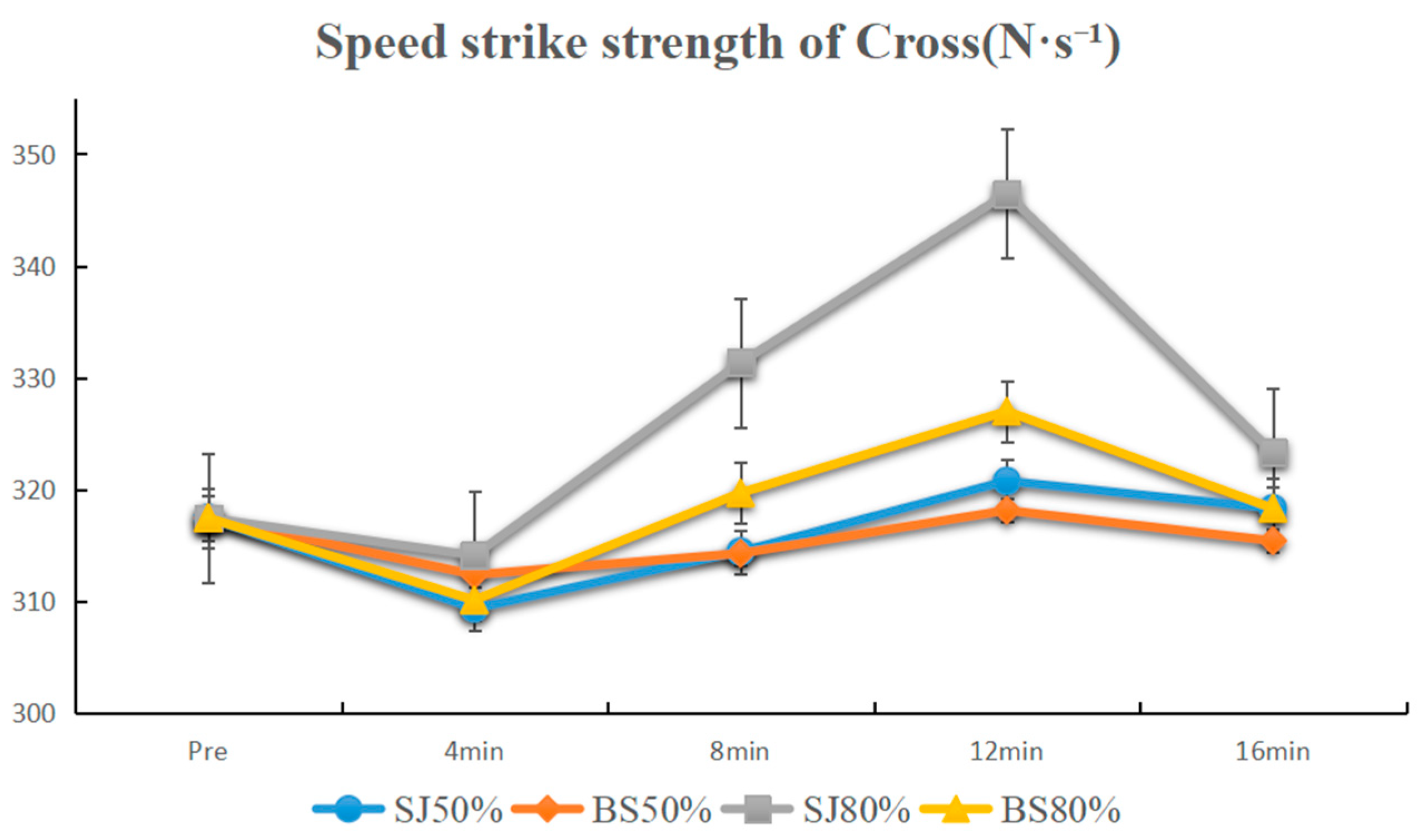
| Condition | Pre | 4 min | 8 min | 12 min | 16 min |
|---|---|---|---|---|---|
| Jab SJ50% | 237.79 ± 3.79 (0.70) | 231.83 ± 4.40 ** (0.82) | 243.83 ± 4.18 **&& (0.78) | 246.31 ± 3.77 ** (0.70) | 235.62 ± 4.36 && (0.81) |
| Jab BS50% | 235.83 ± 4.17 (0.77) | 241.72 ± 3.61 **&& (0.67) | 244.69 ± 4.44 ** (0.82) | 239.28 ± 4.64 & (0.86) | |
| Jab SJ80% | 241.45 ± 4.07 (0.76) | 243.66 ± 4.01 * (0.74) | 248.93 ± 4.01 **& (0.74) | 239.69 ± 4.46 && (0.83) | |
| Jab BS80% | 238.72 ± 3.95 (0.73) | 242.14 ± 4.94 & (0.92) | 245.41 ± 4.13 ** (0.77) | 237.21 ± 4.86 && (0.90) | |
| Cross SJ50% | 291.72 ± 6.45 (1.20) | 287.66 ± 5.92 (1.10) | 298.24 ± 6.42 **& (1.19) | 311.66 ± 5.98 **& (1.11) | 298.62 ± 6.21 & (1.15) |
| Cross BS50% | 284.59 ± 6.36 (1.18) | 295.10 ± 7.00 & (1.30) | 301.72 ± 7.15 ** (1.33) | 293.76 ± 6.57 & (1.22) | |
| Cross SJ80% | 286.69 ± 6.94 (1.29) | 315.35 ± 6.63 **&& (1.23) | 328.59 ± 5.99 **&&# (1.11) | 316.90 ± 7.63 **&& (1.42) | |
| Cross BS80% | 283.38 ± 6.54 (1.21) | 307.35 ± 6.80 **&& (1.26) | 311.48 ± 6.05 ** (1.12) | 304.86 ± 6.23 ** (1.16) |
| Condition | Pre | 4 min | 8 min | 12 min | 16 min |
|---|---|---|---|---|---|
| Jab SJ50% | 261.76 ± 6.39 (1.19) | 257.21 ± 4.70 (0.87) | 264.17 ± 4.37 (0.81) | 269.55 ± 3.92 ## (0.73) | 254.52 ± 4.59 && (0.85) |
| Jab BS50% | 254.41 ± 4.43 (0.82) | 257.55 ± 3.80 (0.71) | 253.21 ± 4.76 (0.88) | 249.48 ± 4.90 (0.91) | |
| Jab SJ80% | 256.62 ± 4.26 (0.79) | 267.38 ± 4.23 &&## (0.79) | 269.55 ± 4.27 ** (0.79) | 253.17 ± 4.51 && (0.84) | |
| Jab BS80% | 253.52 ± 4.15 * (0.77) | 249.62 ± 5.23 (0.97) | 256.31 ± 4.10 (0.76) | 249.31 ± 5.19 (0.96) | |
| Cross SJ50% | 317.45 ± 9.26 (1.72) | 309.35 ± 6.17 (1.15) | 314.45 ± 6.69 (1.24) | 320.76 ± 6.16 (1.14) | 318.31 ± 6.37 (1.18) |
| Cross BS50% | 312.38 ± 6.65 (1.23) | 314.28 ± 7.38 (1.37) | 318.14 ± 7.51 (1.39) | 315.41 ± 6.76 (1.26) | |
| Cross SJ80% | 314.10 ± 7.35 (1.36) | 331.35 ± 7.02 **&& (1.30) | 346.45 ± 6.15 **&# (1.14) | 323.31 ± 7.71 && (1.45) | |
| Cross BS80% | 310.10 ± 6.83 (1.27) | 319.69 ± 7.13 (1.32) | 327.00 ± 6.36 (1.18) | 318.31 ± 6.28 (1.17) |
Disclaimer/Publisher’s Note: The statements, opinions and data contained in all publications are solely those of the individual author(s) and contributor(s) and not of MDPI and/or the editor(s). MDPI and/or the editor(s) disclaim responsibility for any injury to people or property resulting from any ideas, methods, instructions or products referred to in the content. |
© 2025 by the authors. Licensee MDPI, Basel, Switzerland. This article is an open access article distributed under the terms and conditions of the Creative Commons Attribution (CC BY) license (https://creativecommons.org/licenses/by/4.0/).
Share and Cite
Liu, Y.; Jin, R.; Chen, C. Post-Activation Potentiation’s Impact on Specialized Strike Strength in Elite Male Boxers: An Acute Study. Sensors 2025, 25, 6356. https://doi.org/10.3390/s25206356
Liu Y, Jin R, Chen C. Post-Activation Potentiation’s Impact on Specialized Strike Strength in Elite Male Boxers: An Acute Study. Sensors. 2025; 25(20):6356. https://doi.org/10.3390/s25206356
Chicago/Turabian StyleLiu, Yongfu, Rangxi Jin, and Chao Chen. 2025. "Post-Activation Potentiation’s Impact on Specialized Strike Strength in Elite Male Boxers: An Acute Study" Sensors 25, no. 20: 6356. https://doi.org/10.3390/s25206356
APA StyleLiu, Y., Jin, R., & Chen, C. (2025). Post-Activation Potentiation’s Impact on Specialized Strike Strength in Elite Male Boxers: An Acute Study. Sensors, 25(20), 6356. https://doi.org/10.3390/s25206356





